Built 1905–1908 Designated NHL December 30, 1970 Opened 1908 Added to NRHP 17 April 1970 | NRHP Reference # 70000240 Area 2,000 m² | |
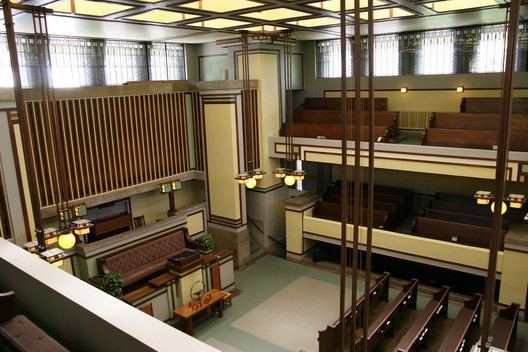 | ||
Similar Frank Lloyd Wright Ho, Robie House, Larkin Administration Building, Johnson Wax Headquarters, Darwin D Martin House | ||
John lobell frank lloyd wright larkin bldg unity temple
Unity Temple is a Unitarian Universalist church in Oak Park, Illinois, and the home of the Unity Temple Unitarian Universalist Congregation. It was designed by the American architect Frank Lloyd Wright, and built between 1905 and 1908. Unity Temple is considered to be one of Wright's most important structures dating from the first decade of the twentieth century. Because of its consolidation of aesthetic intent and structure through use of a single material, reinforced concrete, Unity Temple is considered by many architects to be the first modern building in the world. This idea became of central importance to the modern architects who followed Wright, such as Mies Van Der Rohe, and even the post-modernists, such as Frank Gehry.
Contents
- John lobell frank lloyd wright larkin bldg unity temple
- Background
- Design and construction
- Significance
- Restoration
- References
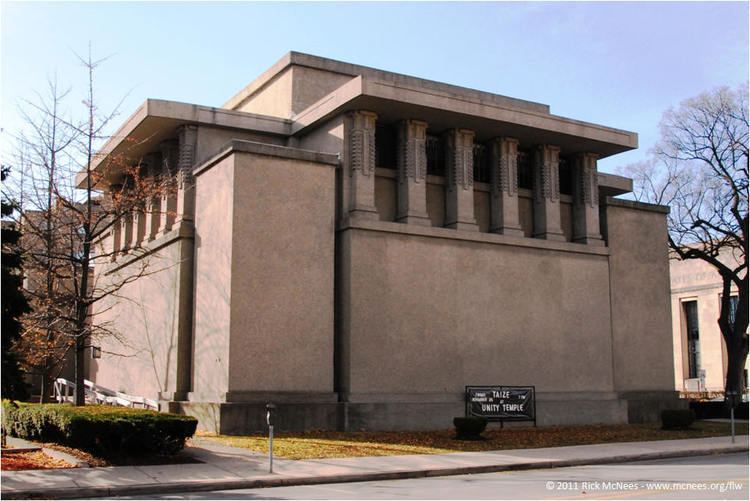
Unity Temple is located at 875 Lake Street, Oak Park Illinois. (The Unitarian Universalist congregation that owns and worships in Unity Temple was formed in 1871, and has no connection with Unity Church, a religious organization founded in 1889.)
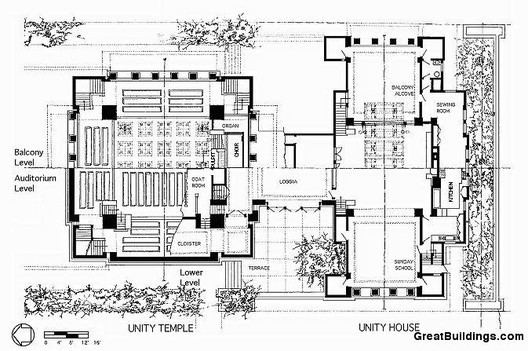
Background
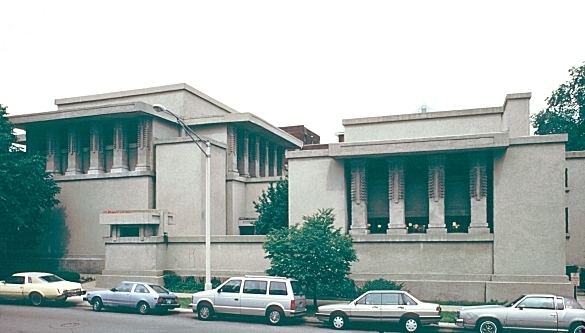
In 1905, after the original Unity Church burned down, the Universalist congregation of Oak Park, Illinois turned to architect Frank Lloyd Wright to design them a new structure. The result was Unity Temple. Wright was not only living in Oak Park, but also came from a family of Unitarians - which faith then had many beliefs in common with Universalism. The congregation needed a space of worship, as well as a community room. There were several immediate problems that the architect had to work with in order to satisfy the client. The budget for the Universalist congregation was rather small for its needs ($40,000 US dollars), and the proposed building site was long, but not very wide. Additionally, the building site stood on a busy street. And finally, the architect was expected to design not only the structure, but also furniture and stained glass for the building. Charles E. Roberts, an engineer, inventor and an important early client of Frank Lloyd Wright, served on the church's building committee and was a key figure in seeing that Wright's vision for the church became a reality. For Roberts, Wright also remodeled Roberts' home and the Charles E. Roberts Stable.
Design and construction
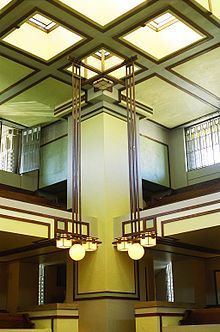
To accommodate the needs of the congregation, Wright divided the community space from the temple space through a low, middle loggia that could be approached from either side. This was an efficient use of space and kept down on noise between the two main gathering areas: those coming for religious services would be separated via the loggia from those coming for community events. The plan of the design looks back to the bipartite design of his own studio built several blocks away in 1898: with two portions of the building similar in composition and separated by a lower passageway, and one section being larger than the other. The Guggenheim Museum in New York City is another bipartite design. Also for the Temple's architecture, Wright borrowed several attributes from his previous creation, the Larkin Administration Building. Key features derived were use of stained glass windows as well as geometric figure. But, unlike the Larkin Building, the Temple's plan produced a perfect square, as opposed to the double-square rectangle of the Larkin.
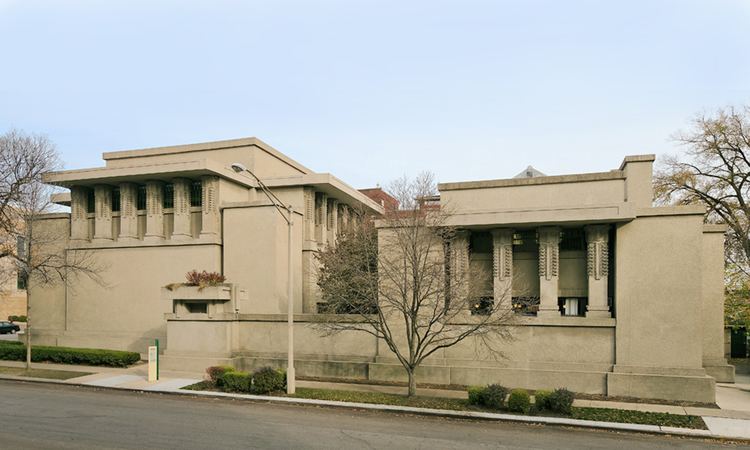
To reduce noise from the street, Wright eliminated street level windows in the temple. Instead, natural light comes from stained glass windows in the roof and clerestories along the upper walls. Because the members of the parish would not be able to look outside, Unity Temple's stained glass was designed with green, yellow, and brown tones in order to evoke the colors of nature. The main floor of the temple is accessed via a lower floor (which has seating space), and the room also has two balconies for the seating of the congregation. These varying seating levels allowed the architect to design a building to fit the size of the congregation, but efficiently: no one person in the congregation is more than 40 feet from the pulpit. Wright also designed the building with very good acoustics.
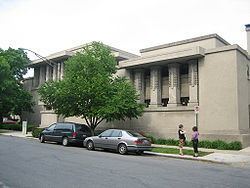
The design of Unity Temple represents a leap forward in design for Wright. In recounting his experiences with Unity Temple, he stated that this design was the first time he ever realized that the real heart of a building is its space, not its walls. Indeed, architectural historians have commented on Wright's genius in creating and manipulating space in his designs; in his book The Master Builders, Peter Blake entitled the section on Wright "The Mastery of Space."
In addition to being very accomplished with making the most out of the space he had, Wright also found the concept of "Unity" was very prominent mainly because of how he managed to fuse together space, experience and the material world. This was key to Unity Temple which has both a common meeting area and the congregation of church-goers. The sanctuary space gives the best example of this according to practicing architect Robert McCarter.
The building was completed in 1908 and officially dedicated on September 26, 1909. The original Universalist (now Unitarian Universalist) congregation [1] still owns and uses Unity Temple, although a separate and secular organization, the Unity Temple Restoration Foundation [2], is in charge of the building's multimillion-dollar restoration effort. Chicago restoration architect Gunny Harboe is in charge of the restoration with CTLGroup providing the engineering and materials technology expertise. In April 2009, Unity Temple, due to water seepage, was added to the National Trust for Historic Preservation's 11 most endangered historic places
Significance
The building has been a United States National Historic Landmark since 1971 and was chosen in a 1991 poll in the magazine, Architectural Record as one of the 100 most significant buildings in the United States of the previous 100 years (Unity Temple was #6). Additionally, Unity Temple was chosen by the American Institute of Architects as one of 17 buildings by Frank Lloyd Wright that should be retained as his architectural contribution to American culture.
In 2008, the U.S. National Park Service submitted Unity Temple, along with nine other Frank Lloyd Wright properties, to a tentative list for World Heritage Status. The 10 sites have been submitted as one, total, site. The January 22, 2008 press release from the National Park Service website announcing the nominations states that, "The preparation of a Tentative List is a necessary first step in the process of nominating a site to the World Heritage List."
Restoration
A drawback to the modern design of the Unity Temple is structural problems that have emerged over time. Through the years of its existence, the Unity Temple's concrete structure has suffered extensive water damage. Pieces of the roof fell inside the structure, and water eroded other parts of the exterior, as well.
A restoration plan was developed from 2000 to 2006, and beginning in April 2015, a $23 million interior and exterior restoration began. The restoration focused on structural improvements such as replacing the majority of the building's 16 separate flat roofs. The restoration also addressed decorative and environmental improvements to the building. The Unity Temple closed to the public in June 2015; restoration is slated to be completed by November 2016. [3]
